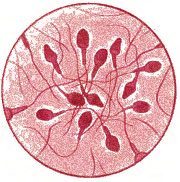Sperm Mapping™ in Los Angeles & San Francisco, CA

A Minimally Invasive Approach to Finding Sperm
You may be inclined to give up all hope of conceiving after learning that you are “sterile,” but that diagnosis does not have to be the end of your fertility journey. Male infertility expert Dr. Paul Turek has helped thousands of patients to find “hidden” sperm that can be used to produce a child. Sperm mapping™ technology shows incredible promise for men that have been told they are infertile due to non-obstructive azoospermia (i.e., a lack of sperm in the ejaculate). Developed by Dr. Turek, the minimally invasive technique can find sperm in areas of the testes that may have gone unnoticed during conventional sperm extraction procedures.
Sperm mapping™, also known as “FNA mapping” or “testicular mapping,” helps men with the most severe forms of infertility, including cancer survivors, become biological fathers. In a recently published study of the sperm mapping™ technique, Dr. Turek found sperm in one-third of men who had failed microdissection testicular sperm extraction (microTESE) procedures. He has also published that sperm mapping™ can find hidden sperm in as many as 45% of men who have failed conventional testicular sperm extraction procedures (TESE).*
If you have a diagnosis of non-obstructive azoospermia, there is hope. Dr. Turek invites you to schedule a consultation with him to discuss your options.
Understanding Azoospermia
When a man has no detectable amount of sperm in his semen, the condition is called azoospermia. Azoospermia affects 1 in 100 men and is responsible for as many as 10% of the total cases of male fertility. Obstructive azoospermia describes men who produce sperm normally, but the sperm outflow is blocked in some manner from reaching the ejaculate. Non-obstructive azoospermia is when sperm are not produced normally or not at all and can be attributed to a number of causes (genetics, disease, hormonal imbalance, testicular failure) other than blockage. Sperm mapping™ is most beneficial for patients who have non-obstructive azoospermia but can also help distinguish whether a man has obstructive or nonobstructive azoospermia.
An Overview of Sperm Mapping™

Sperm mapping™ is based on the fine needle aspiration (FNA) technique, which is currently very popular in many other areas of medicine. After numbing the scrotum, Dr. Turek collects tiny (1/10 of a drop) samples from all areas of the testicles through small needles. The samples are stained and then precisely and systematically examined for hours under a microscope for the presence of sperm. Since the found sperm are stained, they are not usable for assisted reproduction, which means that FNA mapping is an entirely diagnostic technique. The results help Dr. Turek to create a sperm map™ showing where sperm can be found with a future sperm retrieval.
FNA sperm mapping™ takes about 45 minutes and can be performed in Dr. Turek’s office with local anesthesia (with the option for sedative medication). There is no need for an operating room or an anesthesiologist. The procedure is minimally invasive and incision-free, with very little pain. Patients are allowed to return to normal activity within a day or two.
When other methods for locating sperm come up short, sperm mapping™ is an incredibly simple but very cutting edge and thorough way to know more confidently whether any sperm is present in the testicles that might be used for assisted reproduction.
Optimizing the Sperm Retrieval Process
Like a GPS system that maps out the most efficient route on a long drive, sperm mapping™ not only tells Dr. Turek whether the testes are producing sperm, but also where it is located and how much is present. He can later go back and use the “map” to retrieve the sperm so it can be used for in vitro fertilization (IVF) and intracytoplasmic sperm injection (ICSI) for pregnancies.
The information Dr. Turek gathers during sperm mapping™ has been demonstrated to make sperm retrieval procedures faster, less invasive and more comfortable. As it takes the guesswork out of the process, it is much more efficient than any other method. If there is usable sperm lost somewhere in the testes, Dr. Turek can find it with this method. Retrieving sperm without information from sperm mapping™ is like driving around on a half-full tank of gas without a map: you don’t know how long it will take to reach your destination, or if you will run out of gas before you get there. This scenario of ‘blind’ sperm retrieval increases the likelihood that you might not find any sperm or enough sperm to be used for IVF-ICSI.
Other Advantages of Sperm Mapping™ over Traditional Techniques
Many sterile men undergo testicular biopsies to evaluate their candidacy for being biodads. These are painful and involved procedures in which testicular tissue is removed by surgical biopsy. Sutures are necessary to rejoin the skin and testicles at incision points. Some patients experience swelling, bleeding, infection and/or discoloration of the scrotum. The removed tissue is examined under a microscope to determine if a blockage is the source of fertility issues or if testicular sperm are present.
In addition to being better at finding sperm, sperm mapping™ has a significantly shorter and easier recovery than traditional biopsy techniques. Men experience less discomfort after the procedure and can get back to their normal daily activities far more quickly.
Sperm mapping™ is also better for the long-term health of the testis because it conserves as much tissue as possible. Traditional “blind” testicular procedures are more involved in that they require numerous, much larger biopsies and remove significantly more testicular tissue which can jeopardize testosterone levels (since testis biopsy procedures also indiscriminately remove the testosterone-producing Leydig cells from the testicle).
Sperm mapping™ is beneficial from a cost standpoint as well. Sperm retrieval and IVF-ICSI are expensive procedures, so it makes sense to know in advance of undergoing them whether sperm will be found in the testes. If nothing is found with sperm mapping™, then sperm retrieval can be skipped altogether and IVF avoided as there is only a 1% chance that sperm was missed by this technique.
On the contrary, Dr. Turek’s success rate at retrieving sperm that is previously identified with sperm mapping™ is 95%-100%. This means that IVF can be confidently pursued using fresh testicular sperm without the need for having “backup” donor sperm, or freezing unfertilized eggs, or canceling IVF cycles after they have been started. Patients who pursue “blind” sperm retrievals without advanced knowledge of sperm presence provided by sperm mapping™ will need to consider having “backup” plans for IVF and sperm in 50% of cases.
Learn More about Sperm Mapping™ from Dr. Paul Turek
Sperm mapping™ has helped thousands of men facing infertility realize their dreams of building a family. The power of this technology was most recently demonstrated in a published study by Dr. Turek of over 80 men from around the world who underwent sperm mapping™ after failing large microdissection testicular sperm extraction procedures. Dr. Turek found hidden sperm in almost 1/3 of these men. Upon targeted sperm retrieval procedures in these mapped men, sperm were found in all cases and excellent pregnancy and birth rates achieved. These fantastic results have led to Dr. Turek being hailed as the “Sperm Whisperer” by his colleagues in the field.
To discuss sperm mapping™ with internationally renowned male infertility expert Paul Turek, M.D., please contact The Turek Clinic today.
* Turek PJ, Imok Cha, and Ljung, B-M. Systematic Fine Needle Aspiration of the Testis: Correlation to Biopsy and the Results of Organ “Mapping” for Mature Sperm in Azoospermic Men. Urology. 49: 743-748, 1997.









